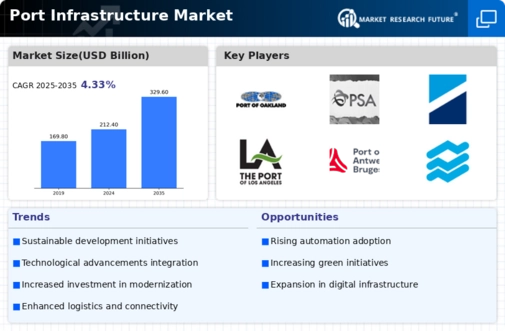Market Growth Projections
The Global Port Infrastructure Market Industry is projected to experience substantial growth in the coming years. With a market valuation of 212.4 USD Billion in 2024, it is anticipated to reach 329.6 USD Billion by 2035, reflecting a robust compound annual growth rate of 4.08% from 2025 to 2035. This growth trajectory indicates a strong demand for enhanced port facilities and services, driven by factors such as increasing global trade, technological advancements, and government investments. The market's expansion is likely to create new opportunities for stakeholders across the port infrastructure ecosystem.
Increasing Global Trade Volumes
The Global Port Infrastructure Market Industry is experiencing a surge in demand driven by increasing global trade volumes. As economies worldwide continue to expand, the need for efficient port facilities becomes paramount. In 2024, the market is valued at approximately 212.4 USD Billion, reflecting the critical role ports play in facilitating international trade. The growth in e-commerce and consumer demand for imported goods further exacerbates this trend, necessitating enhanced port capabilities. This increase in trade is expected to propel the market forward, with projections indicating a market size of 329.6 USD Billion by 2035, highlighting the importance of robust port infrastructure.
Rising Demand for Container Shipping
The Global Port Infrastructure Market Industry is significantly impacted by the rising demand for container shipping. As global supply chains become more complex, the need for efficient container handling and storage facilities is paramount. Ports are adapting to accommodate larger container ships, which require specialized infrastructure and services. The growth in containerized cargo is expected to drive investments in port facilities, ensuring they can handle increased volumes. This trend is likely to be a key driver of market growth, as ports strive to enhance their capabilities to meet the evolving needs of the shipping industry.
Technological Advancements in Port Operations
Technological innovations are transforming the Global Port Infrastructure Market Industry, enhancing operational efficiency and safety. Automation, artificial intelligence, and IoT applications are being integrated into port operations, streamlining processes such as cargo handling and logistics management. These advancements not only reduce operational costs but also improve turnaround times for vessels. For instance, the implementation of automated cranes and smart containers is becoming increasingly prevalent. As ports adopt these technologies, they are likely to see improved service levels and increased capacity, which are essential for meeting the demands of a growing global trade environment.
Government Investments in Infrastructure Development
Government initiatives play a crucial role in shaping the Global Port Infrastructure Market Industry. Many countries are investing heavily in port infrastructure to enhance their competitive edge in global trade. These investments often focus on modernizing existing facilities and constructing new ones to accommodate larger vessels and increased cargo volumes. For example, various nations have allocated substantial budgets for port upgrades, reflecting a commitment to improving trade efficiency. Such investments are expected to contribute to a compound annual growth rate of 4.08% from 2025 to 2035, indicating a sustained focus on infrastructure development.
Environmental Regulations and Sustainability Initiatives
The Global Port Infrastructure Market Industry is increasingly influenced by environmental regulations and sustainability initiatives. As global awareness of climate change rises, ports are under pressure to adopt greener practices. This includes implementing energy-efficient technologies and reducing emissions from port operations. Many ports are exploring renewable energy sources and sustainable logistics solutions to minimize their environmental impact. Compliance with international standards and regulations is becoming essential for ports aiming to maintain their operational licenses. This shift towards sustainability not only addresses regulatory requirements but also enhances the reputation of ports in the global market.



















Leave a Comment